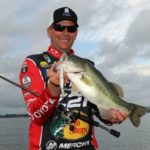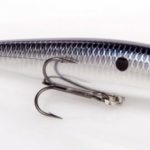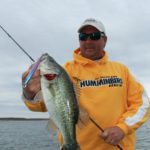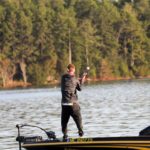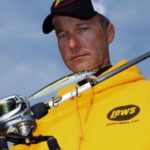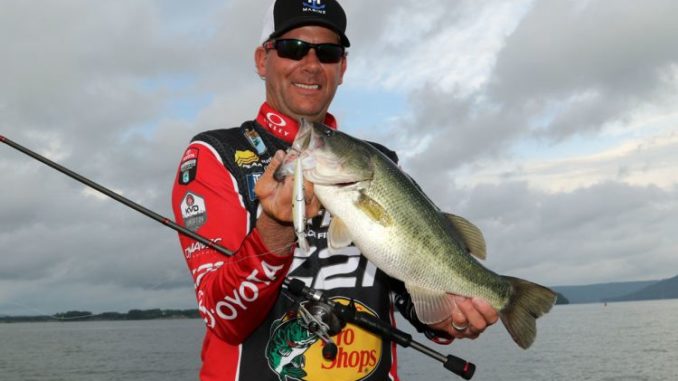
Fall is when bass begin ganging up and following baitfish migrations, and these expert anglers knows jerkbaits are still one of the best producers around.
Word association games show us our true perceptions by drawing forth gut responses.
Say the word “jerkbait,” and many anglers would likely say “cold” — and they would not be entirely wrong.
However, they’d also not be entirely right.
The fact is that jerkbaits boast broader applicability, and throughout Louisiana and Mississippi, fall might be the most-overlooked seasonal applications.
That’s because shad are migrating back into creeks, and bass are hot on their heels with bad intentions.
While plenty of lures can imitate a shad, Bassmaster Elite Series pro Kevin VanDam knows few do a better job of mimicking the baitfish and bringing predators charging.
“A lot of people only think of this as an early season, cold-weather bait, but a jerkbait can be very effective this time of the year because the bass are focused on baitfish,” the four-time Bassmaster Classic champ said. “I’ve done well in (local) waters because a jerkbait does a good job of staying up off the bottom.
“That’s especially important in tidal areas, as well as marshes and swamps with soft, muddy bottoms. If you have a bait that’s on the bottom, it’s down in the mud. So I want a bait that stays up in the water column.”
Toledo Bend guide Stephen Johnston holds the jerkbait in equal esteem. For him, it’s a tried-and-true producer that has taken a backseat to more-modern tactics.
“With the squarebills and the Alabama rigs, you just don’t see as many jerkbaits moving off the tackle shop shelves like you used to,” Johnston said. “But it’s what I call one of the old-school baits.
“The guys that have been around and have done it forever, they always have a jerkbait tied on in the fall.”
So here are some thoughts to reintroduce you to this fish-catching lure and help maximize its use.
Seasonal slant
VanDam favors his signature Strike King KVD 200, a 4½-inch suspending bait made for depths of 4 to 7 feet.
A weight-transfer system enables long casts when schoolers pop up down the creek, while the bait’s wide side-to-side motion and erratic wiggling impersonate fleeing baitfish.
When choosing colors, the Bassmaster Elite Series pro goes with shad patterns such as blue back, chrome and crystal shad.
Water clarity factors into the overall picture so VanDam decks the jerkbait if he encounters too much stain.
“Generally this time of year, you’re going to have a lot of jerkbait scenarios,” he said. “If you have a foot to 18 inches of visibility, this is definitely a really viable technique.”
Darold Gleason, who also specializes in catching Toledo Bend’s big bass, said he likes throwing jerkbaits around schooling fish.
Because the frenzied activity often leaves a few wounded shad struggling in the water column, a jerkbait makes an easy target for attacking bass.
In this scenario, Gleason throws the 6th Sense Provoke jerkbait in shad colors. Fished on 12-pound fluorocarbon, the bait reaches 4- to 8-feet to tempt bass that might be running shad balls throughout the water column.
Johnston said he expects to find shifting weather taking its toll on the baitfish in fall’s later reaches. When mornings require a hoodie and an outer jacket, you can bet the baitfish are feeling it, too.
“This is a huge transition time, with the shad moving farther into the creeks and the water temperatures falling,” he said. “Later in the fall, the shad will start dying, and that jerkbait mimics those dying baitfish.”
Where they’re best
VanDam expects most of his fall jerkbait opportunities to involve current and grass.
In coastal areas with tidal movement, he’s looking for bass to congregate around points, ditch mouths and canal intersections.
In lakes like Toledo Bend, it’s outside grass lines in major creeks, and ditches lined with grass and timber.
Ambush angles are what Johnston seeks. That could be the ends of grass lines heading into major and secondary creeks, roseau cane point in the tidal regions, or riprap buttressing bridges outside migratory creeks.
“Whether you’re fishing reservoirs, river systems or coastal areas, you’re looking for current — wind, tidal or river — and that habitat where the fish are migrating to follow that bait,” VanDam said. “A lot of times it’s just finding the bait itself. Bass will sometimes show themselves.
“You might see one bust, and then you can go catch a bunch of them because one fish gave away their location.”
Johnston noted that spotting the groceries is as close to a slam dunk as you’ll get.
“A lot of times, on those calm fall days you can see those big balls of shad migrating on your sonar unit, or you might be able to visually spot them moving toward the back of a creek,” he said.
Presentation particulars
Once you locate a bait ball, Johnson said it’s important to control enthusiasm. Feeding bass can often take on a wild tone, but your presentations must be measured and well-planned.
“You don’t want to throw that bait in those balls of shad,” he said. “You want to try to make your casts — especially if you can visually see the bait — on the sides of them.
“I’m not saying a fish won’t go through that big ball of bait and eat a little bit, but if there’s a crippled shad on one side or the other, that’s what he’s going to eat first. So, that’s what you want your bait to look like.”
Contrasting the preferred conditions for common fall reaction baits, Johnston pointed out the jerkbait’s advantage in more-challenging scenarios. You can’t control the weather, he said, but you can equip yourself for all possibilities.
“If you have some wind on a bank in the fall, you can throw a spinnerbait or a squarebill,” Johnston said. “But in calm conditions, when the fish can see that bait coming from so far off, they will stay away from it.
“That’s where the jerkbait is so effective: You can jerk, jerk, jerk, jerk and stop it. You get that erratic action and, as soon as you stop it, that gives the fish just a second to look at the bait before you go back jerking it again.”
Overall, VanDam’s going with a peppy cadence in the fall. No need for those long, yawning pauses often required for January bites, he said.
Put on a show and fall bass will bite.
“The water is still warm and the fish’s metabolism is high, so I’ll use a really aggressive retrieve,” VanDam said. “I don’t necessarily pull it to the boat really fast, but I like to jerk it really hard.
“It’s a very erratic action, and the bait moves quickly when you do jerk it. I have a lot of slack in my line, and I’m working the bait really hard. That gets the fish fired up.
On this point, Johnston agreed
“Most of the time, I’ll go with five to six jerks and then stop,” he said. “You just kind of let the fish tell you what they want. A lot of people fish the way they want to fish, but you really need to (listen to the fish).
“You do not want that bait sitting there too long, because if it sits there too long they can see it. A lot of times, they’ll come up and slap at it and bump it. As soon as they do, stop it for a second or half a second and go back to jerking it again.”
The right tackle
Johnston said fall jerkbaiting doesn’t always require the lengthy casts common to winter efforts. Bass often school around the big balls of shad rolling through the creeks, and shorter casts often do the job.
That being said, one of the biggest mistakes Johnston observes among jerkbait fishermen is using a rod that’s too stiff.
Too much rigidity, he said, stymies the bait’s deal-closing action.
For proper form, Johnston arms himself with a 7-foot Loomis E6x 843C CBR, a medium rod with moderate fast tip that allows him to whip that bait and make it move like it was made to move.
He’ll pair the rod with a 7.6:1 Shimano Chronarch Ci4 baitcaster, but not for rapid bait movement — the rod does that part.
“You want a faster reel for when you need to hurry up and get that cast back in and make another cast to breaking fish,” Johnston explained.
VanDam prefers a 6-foot-10 medium-heavy Quantum Tour KVD rod with a Quantum baitcaster.
When it comes to line, he uses diameter to his advantage.
“When I’m fishing shallow, I’ll upsize my line to keep my bait from getting down to the bottom,” VanDam said. “I may throw my jerkbait on 17- to 20-pound fluorocarbon to make sure it runs shallower.
“I’ll almost always start with 14-pound line and go up because I don’t need a bait to run at its maximum depth like light line would get you to. This time of the year, you’re fishing the bait fast and keeping it up in the water column, and the heavier line helps you do that.”
